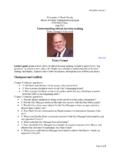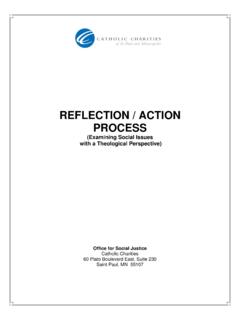Transcription of AFRICAN AMERICAN: COMMUNICATION STYLES …
1 A F R I C A N A M E R I C A N : C O M M U N I C AT I O N S T Y L E SC W M A N D A F R I C A N A M E R I C A N S CWM and AFRICAN Americans share a verbal, visible assertive mode of COMMUNICATION . They differ however, when it comes to personally confronting another person around a hot topic in a direct and forthright manner. AFRICAN Americans will. CWM won t. The position taken by CWM is, Peace before truth or, Better an insincere peace than a sincere quarrel, in those situations that have the potential for generating conflict or push-back. The Don t ask, don t tell conflict avoidant protocol that the military has established for dealing with the gay issue, is another example of the mainstream position, as are caveats about discussing religion and politics in polite circles, or other matters that people are likely to have strong feelings about: such as abortion, or racism.
2 The saying, If you can t say anything nice, don t say anything at all has reached proverbial status and is often recited by CWM and, perhaps even more, by CWW, as a piece of cautionary advice about engaging in hot topics. The personal statement, I can t talk to you now. You re too emotional, often said privately by white men to white women partners, also reflects CWM discomfort with volatile, high energy, contentious discourse. The equivalent statement when things get heated at the corporate level is, Put it in writing. The cultural position of AFRICAN Americans is, Truth before peace , or, Without truth there can be no peace. Expressions that AFRICAN Americans have to promote greater forthrightness are, Tell it like it is!
3 ; Don t sugarcoat it! ; No pain, no gain! 3 Both CWM and AFRICAN Americans see themselves as trying to promote a working relationship. The CWM strategy in that regard is, Don t rock the boat! The AFRICAN american strategy is, Keep it real! Each group sees the other s approach as putting the relationship at risk. What AFRICAN Americans call, Truth-seeking , CWM call Starting a fight. What CWM call Peace-keeping , AFRICAN Americans call, Going along to get along, or, Not caring enough about the person or issue to want to waste the energy on it. A key issue between the two groups in the context of truth-seeking is the value of struggle. CWM see such struggle as polarizing.
4 AFRICAN Americans see it as unifying. In the course of our training we show a picture of a slide of individuals on opposite sides of a rope engaging in a tug of war and ask the group whether they see what s going on as divisive or cooperative. We then ask those who see it as divisive, What makes it divisive? They say opposition : people pulling in different directions. Their model for cooperation is people pulling in the same direction. Most of those in the group that see it as divisive are CWM. We then ask those who see the tug of war as cooperative, What makes it cooperative? Some say, They re playing the same game. Others say, The rope that they are using to pull in opposite directions is also holding them together.
5 Their model for uncooperative behavior is, Letting go of the rope, or, Not picking up the rope. These different views correspond to the different cultural positions of CWM and AFRICAN Americans on the value of contentiousness and struggle around speaking the truth. For example, in a Los Angeles Sentinal interview, Andrew Young, who, at the time, had a post with Working Families for Wal-Mart was asked whether he was concerned Wal-Mart causes smaller, mom-and-pop stores to close. "Well, I think they should; they ran the `mom and pop' stores out of my neighborhood," the paper quoted Young as saying. "But you see those are the people who have been overcharging us, selling us stale bread and bad meat and wilted vegetables.
6 And they sold out and moved to Florida. I think they've ripped off our communities enough. First it was Jews, then it was Koreans and now it's Arabs; very few black people own these stores."4 Andrew Young s remarks were met with heavy criticism, ultimately causing him to resign his post with Wal-Mart. The negative reaction also seemed also to have caught him by surprise. "Things that are matter-of-fact in Atlanta, in the New York and Los Angeles environment tend to be a lot more volatile," he said (italics added).5 In another interview, Young defended his remarks: I was giving a rational explanation of a historic phenomenon, .. Can you talk about ethnicity objectively without it being demeaning or stereotypical?
7 6 All of the above quotes by Young would be considered just telling the truth by AFRICAN american cultural standards. Adding to the volatility for those who thought his remarks were inflammatory might also be the categorical way that mainstream people hear group characterizations: as implicating all members of a group, not just those for whom the shoe fits. With respect to these different cultural perspectives, the head of Human Resources of a university health center got an aha! after listening to the above discussion of black and white COMMUNICATION style differences. She said that, Two of the criteria for assessing respectively negative and positive performance behavior at work were: Creates unnecessary conflict in the workplace, and, Promotes candor in the workplace.
8 AFRICAN Americans were often evaluated by their white supervisors as CULTURAL DIVERSITY TRAINING: INTRODUCTIONFEBRUARY 1, 2010 2009 Kochman Mavrelis Associates, us: : creating unnecessary conflict in the workplace. Conversely, AFRICAN Americans saw themselves as promoting candor. Accounting for the difference in interpretation are the different cultural attitudes around levels of forthrightness, passionate advocacy, and struggle. 3 Kochman, T. 1989. "Black and White Cultural STYLES in Pluralistic Perspective," in Test Policy and Test Performance: Education, language, and Culture. Edited by B. R. Gifford. Boston: Kluwer Academic Publishers. 4 McGhee, B.
9 August 18, 2006. "Andrew Young Resigns from Walmart Post," in Associated Press. 5 Ibid. 6 Dewan, S., Barbaro, M. August 19, 2006. "Different Focus in Atlanta on Young's Remark," in DIVERSITY TRAINING: INTRODUCTIONFEBRUARY 1, 2010 2009 Kochman Mavrelis Associates, us.





